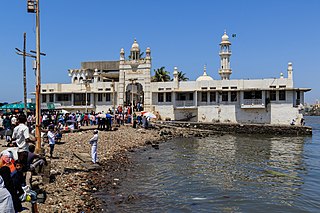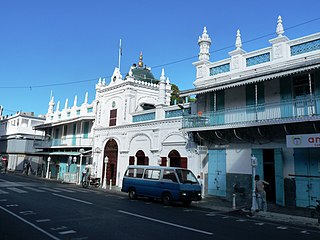
The Haji Ali Dargah is a mosque and dargah or the monument of Pir Haji Ali Shah Bukhari located on an islet off the coast of Worli in the southern Mumbai.

A dargah is a shrine built over the grave of a revered religious figure, often a Sufi saint or dervish. Sufis often visit the shrine for ziyarat, a term associated with religious visits and “pilgrimages”. Dargahs are often associated with Sufi eating and meeting rooms and hostels, called khanqah or hospices. They usually include a mosque, meeting rooms, Islamic religious schools (madrassas), residences for a teacher or caretaker, hospitals, and other buildings for community purposes.

Masjid Jamae or Jamae Mosque [Jawi:(مسجد جامعة (چولية; Tamil: ஜாமிஆ பள்ளிவாசல்] is one of the earliest mosques in Singapore, and is located on South Bridge Road in the Chinatown district within the Central Area. The mosque was established in 1826. This mosque is also known as Chulia Mosque and Periya Palli among the Tamil Muslim community in Singapore. Together with its neighbour, Sri Mariamman Temple, the mosque stands out in its predominantly Chinese location. The Mosque Street that runs beside it may have been named after this mosque.

Qutb ul Aqtab Khwaja Sayyid Muhammad Bakhtiyar AlHussaini Qutbuddin Bakhtiar Kaki (born 1173-died 1235) was a Muslim Sufi mystic, saint and scholar of the Chishti Order from Delhi, India. He was the disciple and the spiritual successor of Moinuddin Chishti as head of the Chishti order, and the person to whom the Qutb Minar, Delhi is dedicated. Before him the Chishti order in India was confined to Ajmer and Nagaur. He played a major role in establishing the order securely in Delhi. His dargah located adjacent to Zafar Mahal in Mehrauli, and the oldest dargah in Delhi, is also the venue of his annual Urs festivities. The Urs was held in high regard by many rulers of Delhi like Qutbuddin Aibak, Iltutmish who built a nearby stepwell, Gandhak ki Baoli for him, Sher Shah Suri who built a grand gateway, Bahadur Shah I who built the Moti Masjid mosque nearby and Farrukhsiyar who added a marble screen and a mosque.

The Jummah Mosque is a mosque in Port Louis, Mauritius dating from the 1850s. The building combines Indian, Creole and Islamic architecture. The Jummah Mosque houses the remains of Jamal Shah in a marble tomb next to the mosque.

Nizamuddin Dargah is the dargah (mausoleum) of the Sufi saint Khwaja Nizamuddin Auliya. Situated in the Nizamuddin West area of Delhi, the dargah is visited by thousands of pilgrims every week. The site is also known for its evening qawwali devotional music sessions. The descendants of Nizamuddin Auliya look after the whole management of dargah Sharif.

The history of Pallapatti dates back to 600 years. It is accessible from the NH 44 connecting Dindigul and Karur. It is located at 46 kilometers from Dindigul and 35 kilometers from Karur, which can be reached through the Aravakurichi town. It is a Muslim majority town which emphasizes on passing traditional & cultural values across generations. The spiritual well-being of the town is visible through several mosques, a church, and a temple. The town stands as an outstanding model for communal harmony that can be seen through the trades owned by people of various communities. The NANKANJI RIVER flows through this town.

Nizamuddin Markaz, also called Banglewali Masjid, is a mosque located in Nizamuddin West in South Delhi, India. It is the birthplace and the global headquarters of the Tablighi Jamaat network, the missionary and reformist movement started by Muhammad Ilyas Kandhlawi in 1926.

According to Sahih al-Bukhari, Muhammad said "Do not prepare yourself for a journey except to three Mosques: Masjid al-Haram, the Mosque of Aqsa (Jerusalem) and my Mosque." In the Islamic tradition, the Kaaba is considered the holiest site, followed by the Al-Masjid an-Nabawi and Al-Aqsa Mosque.
Shah Deccan Qutub Kokan Khwaja Pir Hafiz Habib Ali Shah was born in a Sufi family, whose lineage is traced back to Abu Bakr, the first Caliph of Islam, his ancestors were Sufi masters. From Syedna Abu Bakr Siddiq, the forefathers of Pir Khaja Habib Ali Shah حضرت حبئب علی شاہ obtained the spiritual education (Tassawuf/Tariqat) and bestowed with Caliphat from their fathers

Kazimar Periya Pallivasal or Kazimar Big Mosque is the oldest mosque in Madurai city, Tamil Nadu, India constructed in the year 1284AD and continues to be in existence for more than 7 centuries till today. The mosque was founded by Kazi Syed Tajuddin, a descendant of the Islamic prophet Muhammad, who came from Yemen during 13th century and received this land from the King Kulasekara Ku(n) Pandiyan. The mosque which was the first Muslim place of worship in Madurai. The mosque was managed by Syed Tajuddin during his life time followed by his children and descendants hereditarily for more than 7 centuries till today. Almost all of Kazi Syed Tajuddin's descendants have lived in the same locality for more than 700 years, and have managed the mosque since then.
Makkah Masjid is a mosque in the city of Chennai, India. The dargah of Syed Musa Sha Khaderi is located near the masjid.

Shah Muhammad Ramzan, Molvi Muhammad Ramzan was an Indian Muslim preacher and Tablighi Jamaat in Haryana in what is today India.
The term Rajasthani Muslims is usually used to signify Muslims from the state of Rajasthan in the north-western part of India and speak Hindi, Urdu and Sindhi languages.
Shāh Kamāl Quḥāfah, was a philanthropist, pioneer, social and religious activist.

Maulana Bashir Ahmed Sialvi (1948–2014) was a prominent Sunni scholar and Imam from Pakistan who lead many Ahle Sunnat organisations of Pakistan and served Islam throughout his life. He was born in Chak 164 Shekhan, Gojra, Pakistan. His father Molvi Haji Ilam Dean Sialvi was one of the first settlers to this area after migration from India. He was a prominent member of the Sufi-Sunni Ulemas and Mushaikhs in Pakistan and United States.
Jamaat Ali Shah (1834–1951) was a Sufi saint of the Naqshbandi order and an author. He was President of All India Sunni Conference and the leader of the Shaheed Ganj Mosque. He was an influential leader of the Pakistan Movement.

Begumpur Mosque is a mosque located in Madurai Road, Begampur in Dindigul, the administrative headquarters of the Dindigul district in state of Tamil Nadu. Constructed in the Mughal architectural style, the mosque was built by Haidar Ali. The mosque is named after Ameerunnisa Begum, the younger sister of Hyder, who is buried in the mosque during 1766.















